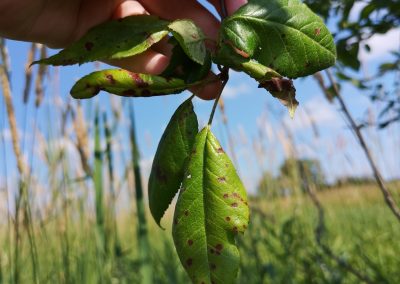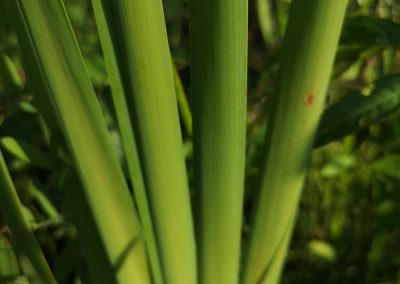Technician Report – Tuesday, November 16th
Black Twinberry ~ By J. Lund
Using the data and pictures collected earlier in the year during our Hollyhock flats plant survey, we have been creating a master list of known species. This guide will aid in training staff and volunteers on plant identification, as well as be a tool for use in the field. Some of the larger native plants we found in July are sweet gale (Myrica gale), black twinberry (Lonicera involucrata), pacific crab apple (Malus fusca), and broadleaf cattail (Typha latifolia).
Sweet gale is a shrub that grows in riparian zones. It gets its name from the fragrant scent of the leaves. Each leaf is covered in fine yellow spots, which are the wax glands of the plant. Sweet gale shrubs can grow 1.5 meters tall and are dioecious; this means there are separate male and female plants.
Twinberry is a shrub in the honeysuckle family. It can grow up to 5 meters tall. The bright yellow flowers grow in pairs and develop into black berries. As the berries mature, the remnants of the flowers deepen to a red colour. It is commonly seen growing in wet conditions.
Pacific crab apple is a tree that grows 12 meters tall. It is often found in mesic areas. These trees usually have two types of leaves; the older ones are highly toothed with three distinct points while the younger ones are rounder with finer teeth. Toothing on a leaf refers to the leaf’s edge having tiny points instead of being smooth. Pacific crab apple trees have white flowers and small reddish fruits that grow in a cluster.
Broadleaf cattail is a tall plant characteristic of marsh areas. They can grow up to 8 feet tall. The leaf blades are thin, but strong and very malleable. This plant was used by coastal indigenous groups to weave items like mats and clothing. Cattail seeds are compressed in a hotdog shaped spike. When the seeds are ready, the spike releases into a cotton-like mass. This light material is attached to the seeds and helps them catch the wind and disperse.
Check out our links on the right for more information about these four species. Are you interested in learning more about native plants and identifying them? E-flora BC is a large database of plants and a useful online guide.
With the help of the Healthy Watersheds Initiative funding Project Watershed has hired environmental technicians to assist with our projects over the summer and early fall. The Healthy Watersheds Initiative is delivered by the Real Estate Foundation of BC and Watersheds BC, with financial support from the Province of British Columbia as part of its $10-billion COVID-19 response. Jamie Lund, one of these technicians, will be posting a brief report every Tuesday to update the Project Watershed community on what they have been up to.
Related Posts
Gwen Janz
Meet our new Forage Fish Lead Biologist!
Eelgrass Update
In the fall our restoration team surveyed the three eelgrass beds which were planted with the help of our volunteers back in June. The beds are looking healthy!
Kus-kus-sum: End of Season Wrap-up
Now that we have put the Kus-kus-sum site to bed for the winter, we wanted to give you all a little update on how things progressed this season – lots happened!
Kate McKeown
Meet our new Forage Fish Technician!
Greenshores at Dyke Road Park – Reimagining a Park
On September 20 and 21, over 20 people were on site to help with planting at the Comox Valley Regional District’s (CVRD) Dyke Road Park redevelopment project.
Gartley Beach Green Shores for Homes Project
Project Watershed is teaming up with the CVRD and the Stewardship Centre for BC to do some shoreline restoration at Gartley Beach in Royston.





